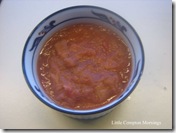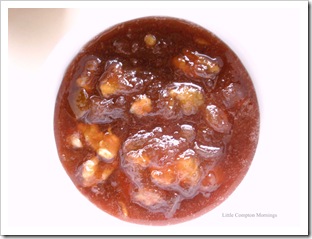 It’s Mother’s Day, and naturally I’m thinking about rhubarb. If you are under 40, unless you grew up around a grandmother or great-grandmother, you probably have not had much experience with rhubarb. Rhubarb was wildly popular with grandparents, many of whom had their own patches, out back somewhere or alongside a driveway. A perennial that is one of the first vegetables to push its way through the ground in the early spring, it was always watched for with anticipation and greeted with what seemed to be misplaced excitement. The plant itself was sprawly and weedy, the leaves poisonous, and the admittedly pretty red stalks cooked down into a mush. As a child, it seemed to me that eating rhubarb was one of the many things peculiar to the strange ways of old people. No one else could possibly like it.
It’s Mother’s Day, and naturally I’m thinking about rhubarb. If you are under 40, unless you grew up around a grandmother or great-grandmother, you probably have not had much experience with rhubarb. Rhubarb was wildly popular with grandparents, many of whom had their own patches, out back somewhere or alongside a driveway. A perennial that is one of the first vegetables to push its way through the ground in the early spring, it was always watched for with anticipation and greeted with what seemed to be misplaced excitement. The plant itself was sprawly and weedy, the leaves poisonous, and the admittedly pretty red stalks cooked down into a mush. As a child, it seemed to me that eating rhubarb was one of the many things peculiar to the strange ways of old people. No one else could possibly like it.My grandmother adored rhubarb, and so did my mother—and she was not, I had to admit, all that old when I was a kid. Still, I shunned the stuff for years, as it was usually served up stewed in our house, which was my mother’s and grandmother’s favorite way to eat it. This pinky-beige mush did not tempt me. But eventually, rhubarb pie did; I am, it is well
 known, a sucker for pie. I quickly became a rhubarb convert—and stewed rhubarb is now one of my favorite ways to eat it, too. I’m sure my age has nothing to do with it. It’s just absolutely delicious.
known, a sucker for pie. I quickly became a rhubarb convert—and stewed rhubarb is now one of my favorite ways to eat it, too. I’m sure my age has nothing to do with it. It’s just absolutely delicious. Rhubarb is available now until early summer; sometimes, there is a second crop in the fall. This is one of many quirky things about this plant. Rhubarb is something that, because of its unique, astringent flavor, is delicious in hot weather; it makes, for example, thirst-quenching drinks and refreshing cold soups and salad dressings as well as the more standard jams, pies (it is, in fact, commonly known as “pie plant”), crisps, and sauces. It’s even nice eaten raw, like the celery it resembles, sprinkled with sugar. Given its hot-weather affinity, rhubarb really should have a season like June-September. But since it does not, I suggest freezing some for hot-weather use, including freezing some of the jam or sauces you might make now. Rhubarb sauce is very nice over creamy vanilla ice cream.
To freeze rhubarb (I provided information on buying and storing it in a recent Edible Rhody article), wash the stalks, trim the ends, and cut slim (1” stalks) crosswise into 1” chunks; for fatter stalks, slice them in half lengthwise, and string if needed, before cutting across. If you have a good freezer, you can pack it raw without sugar, freezing it as you do for berries, first on a cookie sheet and then sealing in double plastic bags. You can also blanch it for about a minute before packing, or pack it raw or blanched in a light syrup made with about ¾ cup sugar to each cup water. Commercially frozen rhubarb is also very good.
Rhubarb is excellent on its own, but I don’t think it’s ever met a fruit it didn’t like: it goes well with strawberries, blueberries, raspberries, pineapple, banana and other tropical fruits, apples, dates and figs, and citrus. It likes spice, especially ground or crystallized ginger, a traditional British addition (the British love rhubarb so much that John Cleese of Monty Python fame once wrote a song proclaiming that “eternal happiness is a rhubarb tart”). If you tire of cooking with it, and you have access to the leaves and roots, you can make insect repellant, cleaning products, or a rinse to lighten your hair. It’s a versatile and delicious plant.
Try some--in honor of your mother or grandmother, of course. Happy Mother's Day.
Spiced Pineapple-Rhubarb Conserve
Rhubarb is a natural for small batch preserving. Makes 2 pints.

3 cups rhubarb in ½” slices, about 6 slim stalks
2 cups chopped fresh pineapple
2/3 cup chopped candied orange peel
½ cup chopped crystallized ginger
3 cups sugar
1 cup light brown sugar, packed
½ tea finely ground black pepper
½ cup coarsely chopped walnuts or pecans (optional)
Combine all ingredients except the nuts in a medium bowl and let macerate for 4 hours, stirring occasionally. In a non-reactive 4 qt pan (e.g., stainless steel or enameled cast iron), bring the mixture slowly to a boil, stirring, then reduce the heat to medium. Cook at a gentle boil, skimming during the first 5 minutes or so, until it sheets from a spoon, about 15 minutes. Stir in the nuts. Pour into clean jars and seal.


No comments:
Post a Comment